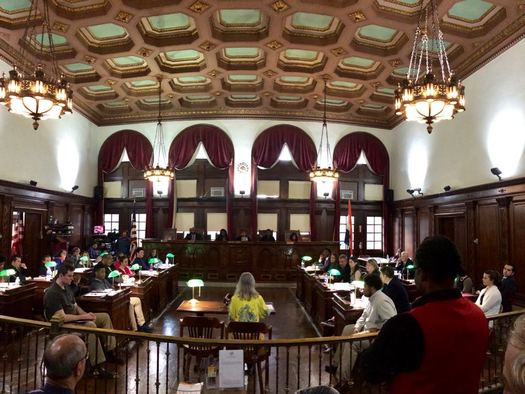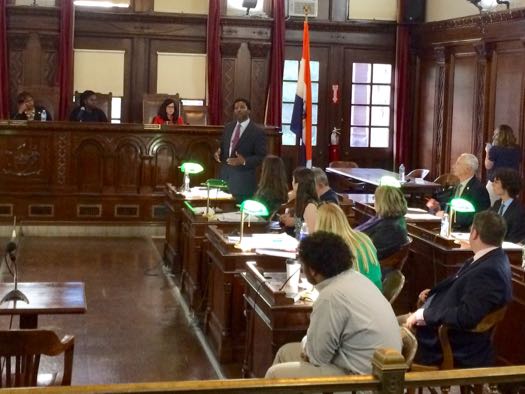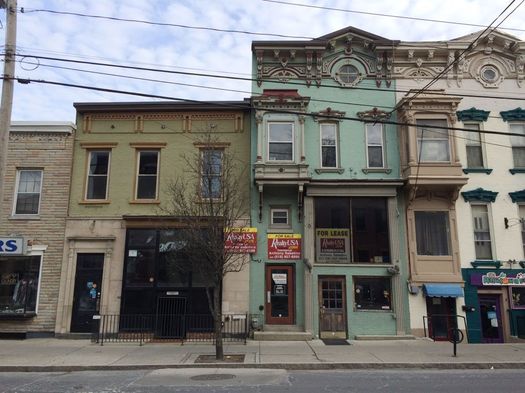Rezone Albany gets the OK -- and a quick overview of what this was all about

Ahead of Monday's vote.
After more than 2.5 years, the big Rezone Albany project reached its conclusion Monday night when the Common Council approved it by a vote of 12-3. It's the first major overhaul of the city's zoning since the 1960s. It takes effect June 1.
As we've said before, zoning might sound sleep-inducing, but it touches on a bunch of questions that regularly get people fired up, such as: What sorts of businesses can open where? How late can they be open? How can old buildings be adapted for new uses? How can neighborhoods suffering from disinvestment gain new life?
Here's a recap of some of the discussion ahead of Monday's vote, along with an overview of what the heck Rezone Albany is...
Praise for the plan
Rezone Albany has been a longterm project for Kathy Sheehan's administration, and after the vote Monday night her chief of staff released a statement from the mayor: "The passage of ReZone Albany marks a tremendous step forward for the City of Albany. This new zoning will help spur investment, protect neighborhoods, and make it easier for homeowners to make improvements to their homes -- all vital parts of building a vibrant and diverse city."
Council members speaking on the floor ahead of the vote echoed many of those themes. Daniel Herring -- the chair of the planning committee, from which the Rezone Albany package of legislation moved -- called the new zoning code "state of the art" and predicted it would allow the city to handle development projects in a "consistent and viable" way.
Cathy Fahey talked about how the new zoning code represents the implementation of many of the goals expressed in the Albany 2030 comprehensive plan.
Richard Conti described how the current zoning sets up a series of obstacles for many new small businesses -- such as restaurants -- and has prompted the city to address problems through spot zoning and variances. "So Rezone streamlines all that. A restaurant is a restaurant is a restaurant. And it creates conformity [of rules] that we don't have today."
And Dorcey Applyrs praised the process of creating the new zoning code. "It has not been easy. But it has been a process that's been open to community input, a very community-centric process."
Applyrs had been one of the of vocal proponents of adding an inclusionary zoning provision to Rezone, which ultimately did make it in (more on that below) after some initial resistance from the Sheehan administration. She praised the work of housing advocates who helped in that push and were willing to compromise to make something happen. And, without mentioning anyone specifically, she also added a message to other members of the council: "It's easy to point fingers about what hasn't been done and what's wrong with this legislation. but there is a lot that's right with it. And for those of us who participated in the process and worked behind the scenes to advocate for the best interests of our residents, I have personally seen what happens when you communicate with people and not fight with them, and take part and be part of the solution and not just be part of the problem."
Criticism and the "no" votes

Mark Robinson speaking ahead of the vote.
As mentioned above, three members voted "no" on the package: Mark Robinson, Frank Commisso Jr., and Judd Krasher.
Robinson delivered an impassion speech explaining his "no" vote, calling for the Rezone legislation to be tabled for further discussion because he said the council had not adequately considered the possibility of folding community benefit agreement requirements into the new code. Such agreements would require developers to, for example, work to connect city residents with jobs on development projects.
"You're not raising the people out of poverty in the community where you're building," he said. "And that's just unfair."
Frank Commisso Jr., who is running for mayor, focused his criticism on the inclusion of the Sandidge Way rezoning in the wider Rezone package -- the street of single-family homes just off Fuller Road is being rezoned to a residential village designation that would allow the construction of apartment buildings. (A group of very persistent Guilderland residents were at the meeting to again express their opposition to rezoning the street.) He said he was concerned the potential payment in lieu of tax arrangement that could granted for a project on the site next to SUNY Poly wouldn't adequately cover the city's cost of serving the area if had greater residential density. And he said any action on rezoning the street should be set aside until the SUNY Poly corruption investigation is completed. [TU]
And Judd Krasher said he believed Rezone would benefit big developers more than average city residents and warned it left many issues unaddressed. "This is not a silver bullet, by any stretch of the imagination. And when all of us wake up tomorrow morning there will still be enormous work to do, housing affordability will continue to be a crisis, and we'll have to do what we can to serve the people and not corporate interests."
Balancing development and neighborhoods
One of the themes that again played out in the comments of both council members who voted "yes" and "no" was the need for the city to balance the interests of neighborhoods and developers.
Mark Robinson criticized Rezone for focusing too much on downtown, the Warehouse District, the waterfront, and "big-pocketed developers" and not enough on neighborhoods such as West Hill, which is in his ward.
Dorcey Applyrs urged leaders to not lose sight of the needs of marginalized people within in the city.
And council president Carolyn McLaughlin -- who's running for mayor -- spoke of finding balance just ahead of the vote: "We have to make sure that the message with Rezone is twofold. One, for me, is that we are open for business. But the other is that we have not forgotten about our neighborhoods. Because businesses and neighborhoods and homes in many of our neighborhoods are very close together and they have to be able to co-exist."
As council president, McLaughlin did not have a vote on the legislation. But afterward she said she probably would have voted "yes" if she did.
What do people know about it?
Another issue raised by McLaughlin was her belief that many people in the city had only recently started paying attention to Rezone Albany and didn't really understand what was in the big package of rules. She called for the city to make an effort to explain the new code in plain English. And after the meeting she said she'd be in favor of a series of events at which city officials could explain what the new changes mean for residents and small businesses.
So, what's in there
The Rezone Albany book is big -- more than 300 pdf pages. And trying to sum up everything in there would be hard. But here are a few big-picture aspects of it (by no means a comprehensive list):
Matching the zoning with how the city is actually used

The new zoning map. Here's an interactive version.
One of the most fundamental parts of any zoning code is that there are different types of zones, and each zone had different allowed uses in them. One of the problems in Albany has been that, over the years, the zoning designation of many properties and how those properties are actually being used have ended up conflicting. Earlier this year, Chris Spencer, the city planning director, said that approximately 21,000 of the city's 30,000 parcels are non-conforming in some way by area -- that is, they conflict in some technical way with the current/soon-to-be-old rules (example: a property that doesn't have enough frontage on a street). And some 6,000 of the city's parcels are non-conforming by use (example: a bar operating in an area zoned only for residential).
That isn't necessarily a problem until someone wants to do something new. But if anyone wants to make changes to those properties -- say, adding a deck -- they're set up for running into a snag that could require a variance.
The city's planning staff and the consultants assisting the city said throughout the process that the goal was to create zones -- and apply them -- to reflect how people are actually using the city. Spencer said back in March that the Rezone Albany package of rules will match the rules to the reality of many of these properties: 15,000 properties in the first category of non-conforming properties and 3,000 in the second will become conforming.
The process matching the city up with the new zones -- and the rules for the zones -- met some opposition in a few cases. Example: You might remember the uproar last year about some businesses in/near the Lark Street commercial corridor having to roll back their late-night closing time under the proposed new rules. And in that case a compromise was struck: Businesses currently operating in ways that would be out of bounds under the new rules -- like the Palais Royale -- will be grandfathered in. And that exception will be attached to the property, so it will continue even if the business is sold. (The new zoning also relaxes a lot of rules for businesses in the corridor, such as allowing them to use the second floor or staying open until 2 am without variances.)
It is likely that some of these new rules might not end being the best fit when they're actually put into use. Multiple Common Council members mentioned Monday that tweaking the rules will no doubt be necessary. And Rezone includes mandated reviews at the six-month mark and then annually after that at which the city must report on things like the number of variances issued.
A goal to make things easier

Officials say the buildings at 268 and 288 Lark Street are two examples of how the city's current zoning holds back development.
To go along with that idea of matching the zoning to how the city is actually used, one of the goals of Rezone Albany is to take down some of the administrative barriers for opening a new businesses. An example touted by the city's planning staff has been 286 and 288 Lark Street -- vacant since Legends and DeJohn's closed years ago. Ali Celik, owner of Mercato's and Extra Napkin Grill in Delmar, is working to open two new food establishments there. Under the old rules he'd need a whole slate of variances:
Here's that list of variances:
+ restaurant serving alcohol
+ tavern
+ use of the second floor
+ operation until 2 am
+ variance for parcel width less than minimum
+ variance for parcel width less than minimum
(The site is two parcels and each would need a variance.)
And under the Rezone Albany rules, the list of required variances would be:
+ tavern
It might not seem like a big deal to go through the process of getting the variances. But the requirement adds steps and uncertainty to the process of opening a business. Also: Any complicated process is going to advantage people/companies/developers with the resources or expertise to navigate the maze. Cutting out some of the complications theoretically should help level the playing field a bit.
Mixed use

New designated areas in Warehouse District. It's one of three new "form-based" districts that include proposed specific standards for shaping the look and feel of new development.
The Rezone Albany package also includes a handful of new mixed-use zones aimed at providing flexibility for the types of uses in neighborhoods such as the Warehouse District. In fact, a new mixed-use overlay already in effect there has smoothed the way for the planned residential conversion of the Nipper Building, which would have previously required a variance for such a use.
Rezone also includes three "form-based" districts -- Warehouse District, South End, and Central Ave -- that aim to guide development not so much by how buildings are used, but how they contribute to the feel of the neighborhood.
Affordable housing and different housing
Affordable housing and Rezone became a hot topic as the process neared its completion, with the addition of an inclusionary zoning provision in the last few weeks. We recently covered what that means, so we won't go through that all again. But in short, starting in December, the city will require that new residential projects with 50 or more units to include at least 5 percent of units set aside at rents deemed affordable according to a formula based on the city's median income.
Said Dorcey Applyrs, one of the council members who had pushed for the provision, ahead of Monday's vote: "This is not the ideal piece of legislation, but it does put us a step forward in trying to get affordable housing and get the percentages that we want."
The new code also includes a provision that allows developers to build taller buildings and have less parking if a development includes at least 20 percent of units deemed affordable for a household making 80 percent of the city's median income.
There are also other provisions that city officials say they think will help prompt the creation of new housing -- from that more-flexible mixed-used zoning in places like the Warehouse District, to rules that keep some multi-unit buildings from becoming non-conforming if they sit vacant for too long (as is the case under the current/old rules), to a test of allowing what are known as accessory dwelling units (example: in-law units or something similar).
As Chris Spencer said last week: "Overall, our zoning the way it is right now does a good job of telling people what we don't want and what they can't do. And I think our new zoning really talks about what this community wants, what the city wants, and what you can do."
Say Something!
We'd really like you to take part in the conversation here at All Over Albany. But we do have a few rules here. Don't worry, they're easy. The first: be kind. The second: treat everyone else with the same respect you'd like to see in return. Cool? Great, post away. Comments are moderated so it might take a little while for your comment to show up. Thanks for being patient.
Comments
Thank you. The drum has been beating for years, since the adoption of the comp plan, to get folks involved in rezone. It's not sexy, but it's where the rubber meets the road to implement the vision that the city created in Albany 2030. I know the staff has been working round the clock to develop this new code and MAJOR kudos to them for bringing this forward. This is a big step forward and it's been a long time coming.
... said daleyplanit on May 17, 2017 at 3:44 PM | link
I'm confused why Mr. Celik's development of the Lark Street spaces will STILL need a variance permit for being a tavern even after the Rezone Albany passage -- why would the Council not include taverns as zoned for such a neighborhood that has been a spot for pubs and restaurants for years? He shouldn't need a variance permit at all when it is a business strip to begin with -- doesn't the city want to encourage new businesses opening?
... said gb on May 18, 2017 at 6:17 AM | link
To clarify, the City does not require a variance to open a tavern in the C-1 commercial district. Taverns were allowed in the district, but must hve meet certain conditions (and will continue to need to do so) established by city code under the Special Use Permit.
... said daleyplanit on May 18, 2017 at 11:07 AM | link
First off, I think it’s important to congratulate all the folks, up front and behind the scenes, who worked this process. Its tedious, not sexy, and unfortunately can be fraught with politics, so I think it can’t be said enough that the final product was a heavy lift and players involved will never get the kudos they deserve (and any kudos given will go to the electeds). Secondly, I think it’s important to note that we can’t let the perfect be the enemy of the good on this. I certainly have qualms about particular elements (I don’t think we were radical enough on the parking minimums; I refer to Buffalo which did it right in my opinion), but we don’t live in a homogenous city and you will never appease everyone on everything, so I think this new zoning framework offers a wonderful foundation. Despite some bickering from a minority of politicians (most likely for their own self-serving good), we can always work off of this foundation, which needed a serious dusting off since the last time zoning was comprehensively addressed was during the Vietnam War.
... said Rich on May 18, 2017 at 1:28 PM | link